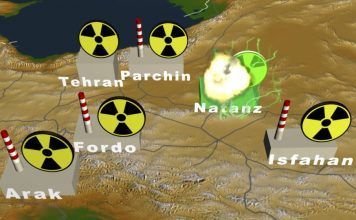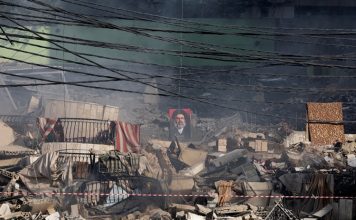By Potkin Azarmehr
[Potkin Azarmehr is an Iran analyst and commentator based in London. The views expressed are his own.]
Two Iranian cities this month were shaken by loud explosions, shortly after Iran’s security forces said they had thwarted an Israeli plot to sabotage Iranian missiles. The blasts, however, appear to be an exact replica of the very plot that Iran’s security forces claimed to have derailed.
On Monday Sept. 18, residents in Gorgan – a city in northeastern Iran with a population of around 300,000 — were shaken when they witnessed eight unexpected explosions. The explosions were followed by large fragments of military hardware falling on various parts of the city.
Iranian state TV at first reported that a single drone had crashed, but because there were eight explosions, the residents believed that a coordinated drone attack had been averted and several drones had been shot down by missiles.
Iran’s Defence Ministry Says Defect in Military System Caused Blast in Northern City
Local officials on Iranian state TV however said that only one drone was shot, and that it fell into eight pieces throughout the city. The speculation continued until Iran’s defense ministry spokesman, Islamic Revolutionary Guards Corps General Reza Talayi-Nik, dismissed the initial reports and told Iran news agencies that there were no drones involved. Rather, a technical failure during a missile test in a desert area had caused the missile warhead to deviate from its path and explode into several pieces over the city.
The eight explosions were explained by the missile warhead’s capability to fragment into eight pieces to strike at multiple targets.
Open source intelligence based on the pictures of the fallen remains published on the social media at first confirmed that it was most likely a Qiam-1 ballistic missile which carries a separable warhead that can break apart into several fragments. Some however pointed out that the serial number C007 suggested it was a Khorramshahr missile.
Shahram Sabzevari, a former Iranian army counterintelligence officer, said in an interview: “The missile that was shot down in Gorgan was one of the Qiam series ballistic missiles with a 1,000-kilometer range. However, the IRGC missile tests make use of a combination of different parts for experimentation. So it is possible that they used a Khorramshahr missile body with a cluster warhead for testing”.
Regardless of what missile went astray, all experts agreed that it was a miracle that no one was killed and that only two people were reported injured in Gorgan. Pictures showed extensive damage to shops and properties and shattered windows. One missile piece even penetrated the front door of a residential apartment, passed through the kitchen and destroyed the occupant’s living room.
Only three weeks earlier, Iran’s defense ministry had boasted that their counterintelligence had foiled the biggest sabotage plot against the country’s missile production by the Israelis.
Deputy Defense Minister Mehdi Farahi appeared on state TV and described how someone identified only by their initials “J.A.”, in charge of circumventing sanctions and procuring missile parts from Western countries, had been recruited by the Israelis. Farahi explained how, through “J.A” – the procurement agent turned Mossad operative — the Israelis learned about the various parts required in Iran’s missiles.
The Israelis then focused on one particular part — the military-grade electrical connectors used in missiles — and planned to make them defective.
Farahi charged the Israelis with setting up a “special laboratory” to study these electrical connectors and how to manipulate them with a circuit board that disabled the missile’s guidance system, causing the warhead to deviate from its path.
He added: “The Israelis then tried to sell us these modified connectors through third-party fake companies, even trying to entice us further by selling them at cut prices.”
Farahi was bombastic that the Israelis were in a state of complete shock after their efforts were unsuccessful. “They were hopeful their success to make our missiles defective would enable them to start a war with Iran, but they failed and we were tracking their agents right from the beginning.”
The Israeli plan that Farahi described to have foiled sounded eerily similar to what happened to the Qiam warhead that fell on the Iranian city of Gorgan. The missile should have headed south towards the desert area; instead, it deviated in the opposite direction towards a populated city in northeastern Iran.
The narrow escape from causing a massive human tragedy in Gorgan did not dampen the bombastic mood of Iran’s Revolutionary Guards commanders. Six days after the Gorgan incident, Iran’s Defense Ministry spokesman General Talaei-Nik spoke in a ceremony in Hamedan, West Iran and said: “Iran is in possession of precision strike missiles. Today, we have missiles at our disposal that we have named ‘Israel-striker’ missiles.”
Only two days after Talai-Nik spoke in Hamedan, locals in Khorramabad — three and a half hours away — reported hearing a huge explosion.The Imam Ali base in Khorramabad houses an underground depot for ballistic missiles and drones. Rumours quickly spread that there had been an explosion in the Imam Ali missile depot.
The authorities attributed the sound of the blast to an earthquake, but when it emerged that the Iranian Seismological Center (IRSC) had not recorded any earthquakes, they said it was because the earthquake was only a magnitude 2 on the Richer scale.
The feeble official explanation only fuelled more speculation of sabotage at the missile depot. Earthquakes with a magnitude of 2.0 or less are usually called microearthquakes; they are not commonly felt by people.
There was a deadly explosion in the Imam Ali Missile Depot before in October 2010, resulting in dozens of casualties. The IRGC affiliated Tasnim News however flatly denied that this was a repeat of what happened 13 years ago and said there were no casualties.
Official denials, however, have not convinced the local residents who heard the blast and saw ambulances and law enforcement vehicles rushing towards Khorramabad’s Shohada-ye Ashayer hospital.
If it was a blast at the missile depot, whether because of Israeli sabotage or an accident, the boast of having foiled the biggest sabotage plot against Iran’s missiles program or the possession of “Israel-striker” missiles that actually strike Iran would be yet another huge embarrassment for Iran’s Revolutionary Guards.













